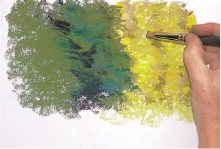
tools for blending
A number of tools are available for blending to soften edges, move color and mix it on the paper. In addition to tools sold commercially for these purposes, there are things you may have in your home that work well for blending. Styrofoam peanuts, the “core” of Fome-Cor (cut a piece off, remove the paper from the front and back, and you have a firm blending tool that can be cut to any size or shape) or even eyeshadow applicators all make good blending tools.
Layering Color
Use layers of pastels over other pastels to blend colors. When you don’t have the color you want, you can create it with layers of colors. You can also layer and intermix colors for optical blending effects, or to create broken color (small strokes of several colors of the same value applied to an area, layered and side-by-side, to create interesting color).

paint shapers
A rubber-tipped paint shaper is similar to a paintbrush, except the “brush“ is a rubber shape with some broad edges and some narrow edges. They work well to blend colors, and can also remove color. I use the Colour Shaper brand.
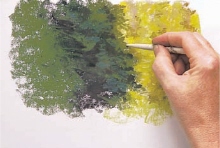
tortillions
Tortillions, or stumps, are traditional pastel and charcoal blending tools. Their fine points can get into small spaces and push the pastel into the paper.
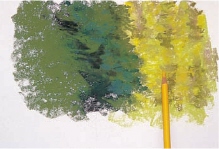
pastel pencils and charcoal
You can use thin sticks of extra-soft vine charcoal or pastel pencils to feather edges. Hold the stick or pencil far back from the point and fan it gently across an area you wish to blend. Using charcoal may gray the color a little, while using pastel pencils may glaze on a little extra color as it blends your pastel pigments.
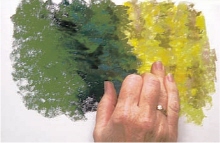
tapping
Create soft edges by tapping the pastel with your fingers. Unlike blending, tapping does not muddy colors but can be useful for softening edges or melding two or more colors together.
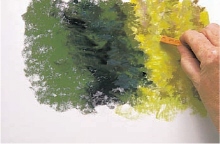
layering
Layering hard pastel over soft is one way to blend while adding color. Try this in an area of foliage: With very soft pastels, put down several greens, perhaps add some oranges, and then lightly stroke over the soft pastels with the side or tip of a firm yellow or yellow-orange pastel. The harder pastel will blend the colors together while adding the impression of sunlight. You can create a similar effect in shadowed areas by using soft pastels in dark colors and then blending with a blue or blue-green hard pastel.
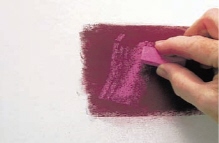
glazing
Glazing with a stroke of soft pastel, holding the stick on its side, is a way to layer color without blending. Where the layer is thinnest, the effect of a different color is created.